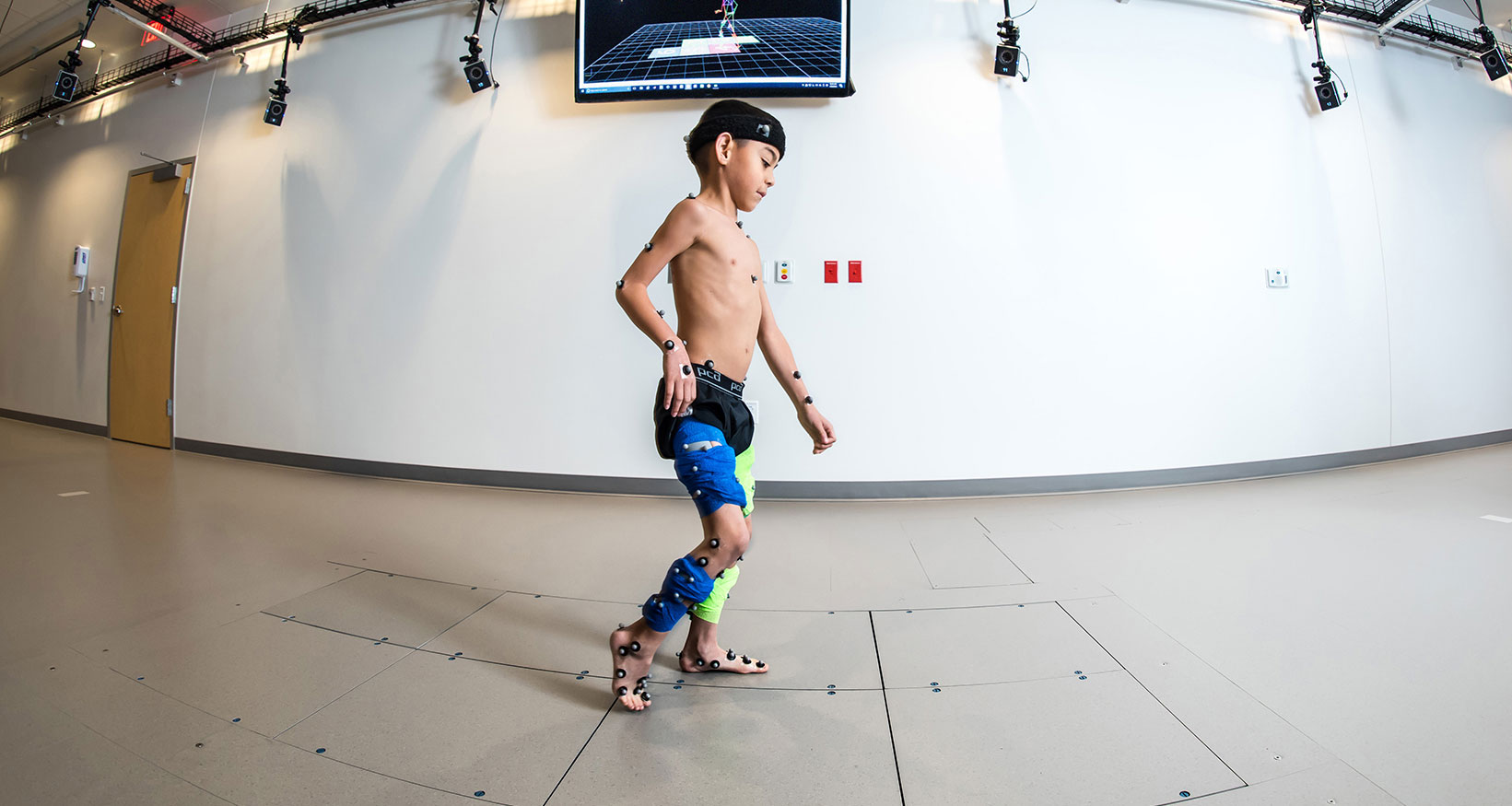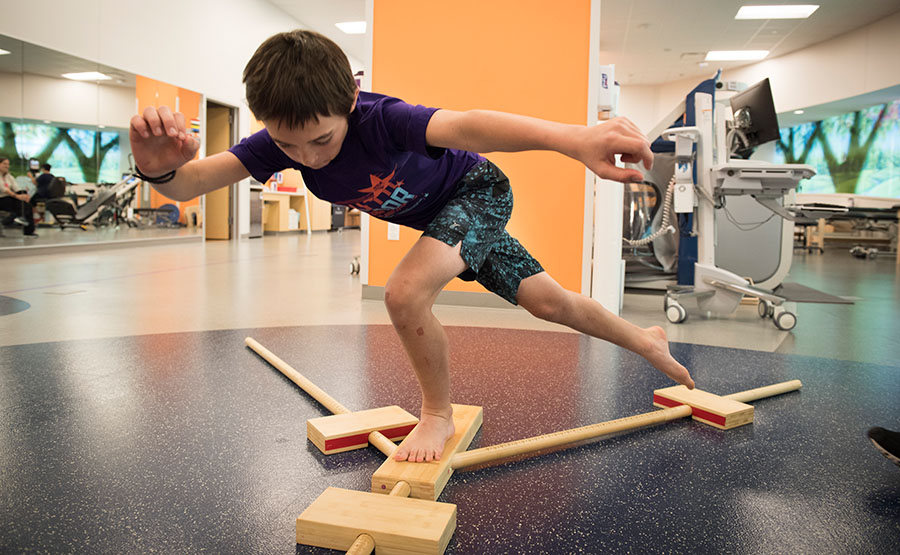

When children have difficulty walking or moving due to medical conditions, there’s only so much that can be seen or done in an ordinary clinic setting. Using advanced motion capture technology, however, providers can identify and catalog gait anomalies with pinpoint accuracy and develop surgical interventions, treatment plans and orthotic devices with equal precision.
At the Motion Analysis and Human Performance Lab at Texas Children’s Hospital The Woodlands, care teams are able to do all this and more for a variety of patients with a full range of mobility issues.
Ariana Fabian, now 5, was diagnosed with prematurity-related cerebral palsy at age 3. Ariana walked on her tiptoes with the help of braces and a walker. She couldn’t keep up with her twin sister, Alexia, who could walk and run unassisted.
Botulinum toxin injections into Ariana’s too-tight muscles helped a little, but her legs did not function as they should have. A special examination in the Motion Analysis Lab helped transform her treatment into a successful outcome.
Established in 2017, the Texas Children’s Motion Analysis Lab is one of only three clinical pediatric labs in Texas and one of only 15 in the nation accredited by the Commission for Motion Laboratory Accreditation.
In the lab, computers and high speed motion capture cameras process information as children walk and/or move with dozens of reflective markers and sensors affixed to their bodies. The data allow an interdisciplinary team to review components of motion during walking including:
“Technology gives you so much more reliable and objective information compared to what I would see just watching a child walk down the hallway in the clinic,” said Aloysia Schwabe, MD, section head of Physical Medicine and Rehabilitation and associate professor at Baylor College of Medicine and chief of Physical Medicine and Rehabilitation at Texas Children’s Hospital.
 Tavish Quinn is evaluated after a sports injury.
Tavish Quinn is evaluated after a sports injury.The most common childhood motor disability – cerebral palsy – affects about four out of every 1,000 children in the United States. Gait analysis is helpful for surgical planning in this and other disorders, such as:
Directed by Eric Dugan, PhD, the lab has expanded to serve not only patients with gait disorders who would benefit from pre-surgical planning to ensure best outcomes, but also athletes, for whom the information collected can guide rehabilitation efforts for improved sports performance after injuries or surgeries.
Jeff Shilt, MD, associate professor of orthopedics at Baylor and chief surgical officer at Texas Children’s The Woodlands, and Dr. Schwabe are medical directors for the lab. They team up with Dr. Dugan and other health care professionals, including physical therapists, biomechanists and exercise physiologists, to put together treatment recommendations for the referring physician to enhance function and overall performance for a wide spectrum of patients.
Typical surgery recommendations for neuromuscular patients may include:
The final report to the patient and the family, as well as the referring physician, frequently includes input on rehabilitation planning and bracing.
“When you’re discussing possible surgeries that will have permanent consequences and require sometimes a prolonged rehabilitation phase, you really need to have the most detailed and accurate information available to review ahead of time and to share with the patient’s care team. Combining the motion analysis data and results from a comprehensive exam and imaging studies presents opportunities for identifying additional components of a surgery that will further enhance the outcome. There may be some situations where a proposed intervention may not reach a threshold for surgery, and observation is the best course of action,” Dr. Schwabe said.
Clinical gait analysis includes these steps:
The whole process takes about two and a half hours on average.
“It was a little bit tiring, but she got through it,” said Rudy Fabian, Ariana’s father. “She’s a soldier. She’s very cognizant of everything that’s going on, including her treatment and her therapy sessions. We try to explain it to her as best we can, and she understands a lot.”
If the referring physicians and the parents are thinking about a surgery, the motion analysis study is usually completed the same year as the proposed surgery so that the child’s growth won’t make the information outdated.
Ariana had a selective dorsal rhizotomy, a neurosurgical procedure that makes movements more fluid and reduces overactive involuntary muscle contractions due to spasticity.
During a several week stay in the Inpatient Rehabilitation Unit at Texas Children’s Hospital, Ariana had intensive physical and occupational therapy working on relearning proper gait mechanics.
“She had to completely relearn how to crawl again and walk again,” Mr. Fabian said. “The whole rehab process was hard on her, but everybody at Texas Children’s was so supportive and got her through it. It was a collective effort from the staff at Texas Children’s to push her through her daily goals.”
After discharge, she continues therapy at least twice a week, supplemented by practice at home. No longer on her tiptoes, her heels now touch the floor, even without leg braces. She has improved balance and is working to build strength in her muscles and to increase flexibility in her hips.
About a year after surgery, a visit to her neurosurgeon, Daniel J. Curry, MD, brought an assessment of significant progress. Dr. Curry is director of Functional Neurosurgery and Epilepsy Surgery at Texas Children’s and a professor of pediatric neurosurgery at Baylor.
“The first thing that she told the doctor was, ‘Thank you for the surgery.’ She was very happy to be there and to thank him,” Mr. Fabian said.
The day after seeing Dr. Curry, Ariana took her first 17 steps without her walker or crutches. Three weeks later, she was up to 70 steps.
In addition to assisting with clinical decision making, the lab coordinates research projects to compare effectiveness of different treatment and surgical techniques. The goal is to keep refining the processes to advance the care of children with gait disorders or other functional limitations so that they are receiving the best possible outcome tailored specifically to each child’s needs. Instead of a one-size-fits-all approach, the team thoughtfully reviews each child’s case to optimize the treatment recommendations, taking the patient’s and family’s goals into consideration.
With the help of gait analysis, children like Ariana may have an easier time joining their friends and siblings when they say, “Come on, let’s go out and play!”